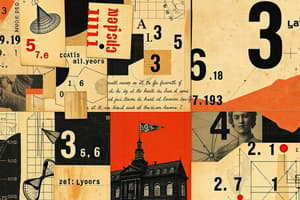Podcast
Questions and Answers
What is the result of the union operation between sets A = {1, 2, 3} and B = {3, 4}?
What is the result of the union operation between sets A = {1, 2, 3} and B = {3, 4}?
- {1, 2, 4}
- {1, 2, 3, 4} (correct)
- {3}
- {1, 2}
If set C = {1, 2, 3} and set D = {3, 4}, what is the intersection of C and D?
If set C = {1, 2, 3} and set D = {3, 4}, what is the intersection of C and D?
- {3} (correct)
- {}
- {4}
- {1, 2}
What does the set difference operation represent in set theory?
What does the set difference operation represent in set theory?
- Creating an empty set
- Removing elements present in both sets
- Combining unique elements from multiple sets
- Removing elements from one set that appear in the other (correct)
Which theorem from set theory demonstrates the non-existence of a 'universal set'?
Which theorem from set theory demonstrates the non-existence of a 'universal set'?
In computer programming, why are sets considered convenient structures for indexing large amounts of data?
In computer programming, why are sets considered convenient structures for indexing large amounts of data?
How do sets benefit statistics applications?
How do sets benefit statistics applications?
What is a Universal Set?
What is a Universal Set?
In set theory, what is a Subset?
In set theory, what is a Subset?
What does a subset represent in relation to a universal set?
What does a subset represent in relation to a universal set?
How are sets usually represented?
How are sets usually represented?
What is the purpose of sets in mathematics?
What is the purpose of sets in mathematics?
Why do mathematicians use different operators when dealing with sets?
Why do mathematicians use different operators when dealing with sets?
Study Notes
Sets in Mathematics
Sets are fundamental concepts in mathematics, used to organize and group objects in a systematic manner. They play a crucial role in understanding various mathematical ideas, from basic arithmetic to advanced theories such as category theory. In this article, we will delve into the world of sets by exploring their different types, operations, theory, and practical uses.
Types of Sets
A set is usually represented by enclosing its elements between curly brackets, like {1, 2, 3} which represents the set containing the numbers one through three. There are two main categories of sets based on how their members can belong to them:
-
Universal Set: This is a collection of all possible elements under discussion. For example, if we're talking about shapes, the universal set could contain circles, triangles, squares, etc.
-
Subset: A subset consists of some, but not necessarily all, of the elements found in another set called the universal set. For instance, let's say our universal set includes birds (sparrows, owls, penguins), then the set of animals living near water would be a subset since it only contains part of that larger group.
There are further distinctions among sets depending on whether they have distinct elements or shared ones; these classifications help us better understand relationships between different groups of things within mathematics.
Operations with Sets
Mathematicians work with several operators when dealing with sets. Some common ones include:
-
Union: When you combine all unique elements from multiple sets together without repeating any member, you get the union. For example, if A = {a, b, c} and B = {c, d}, then A ∪ B = {a, b, c, d}.
-
Intersection: Here you take out anything present in both sets, keeping just what your sets share. Using the previous example, A ∩ B = {} because none of A's elements intersect with those in B.
-
Difference: This operation removes from one set every element that appears in the other(s); set difference is denoted by -. Going back to our illustration, A - B means removing everything in B from A, resulting in a new set {a, b}.
These operations allow mathematicians to manipulate data effectively, analyzing patterns and extracting relevant information from complex datasets.
Set Theory
Set theory deals specifically with sets themselves rather than their contents. It focuses on properties common across all types of collections, including rules governing membership, equality, inclusion, ordering, cardinality and so forth. One famous theorem from set theory is Russell’s Paradox which shows that there cannot exist a 'universal set', contradicting naïve conceptions about universality.
This branch helps formulate precise definitions and derive logical consequences using standard deductive techniques, providing strong tools for solving problems involving multiple sets.
Applications of Sets
The power of sets transcends academic pursuits; it permeates daily life situations too! For instance, databases store records consisting largely of organized sets where each record corresponds uniquely to a specific entity being described. In computer programming languages such as C++ or Python, sets serve convenient structures for indexing large amounts of data efficiently. Additionally, statistics utilizes sets extensively due to their ability to represent populations and samples accurately while avoiding redundancy.
Conclusion
In summary, sets are integral constructs within mathematics offering numerous advantages: organizing information systematically, simplifying complexity via abstract representation, applying logic precisely, facilitating communication among scholars worldwide – these benefits make sets indispensable tools regardless of field or purpose.
Studying That Suits You
Use AI to generate personalized quizzes and flashcards to suit your learning preferences.
Description
Explore the world of sets in mathematics by learning about the different types, operations, set theory, and practical applications. Understand how sets are used to organize data, perform operations like union and intersection, delve into set theory concepts, and discover real-life applications in fields like databases, computer programming, and statistics.




